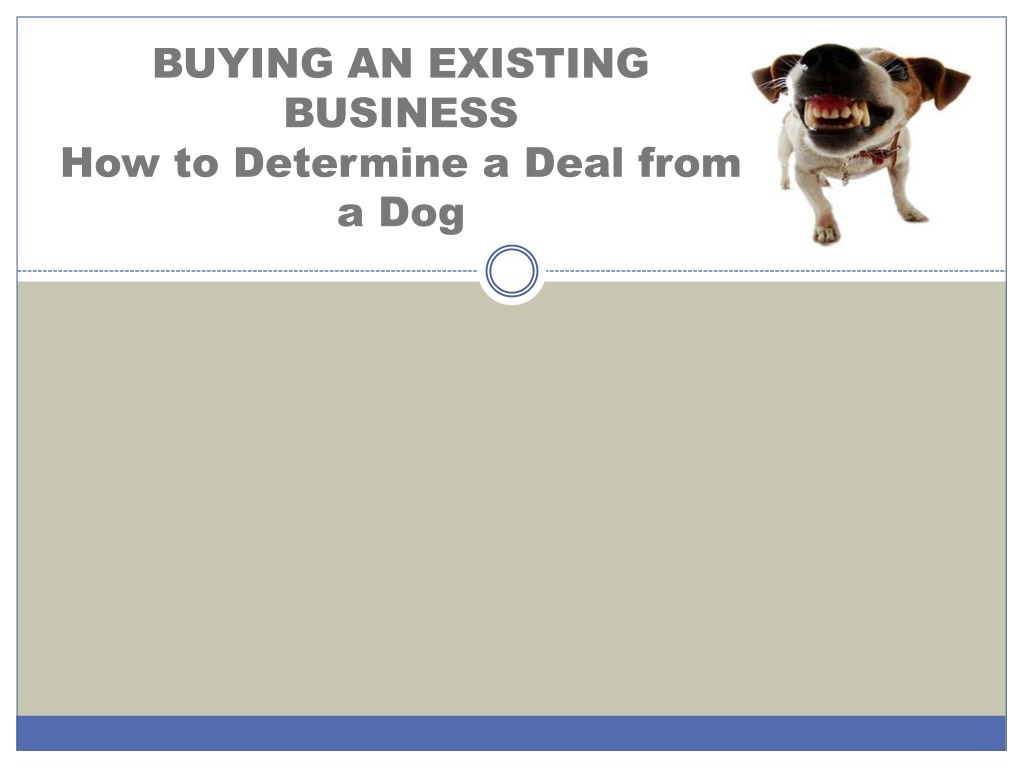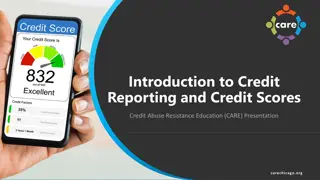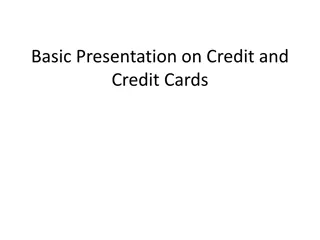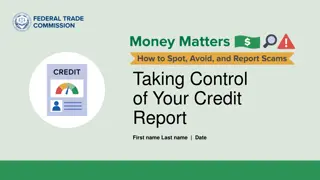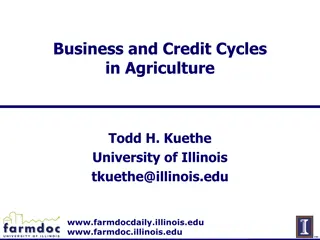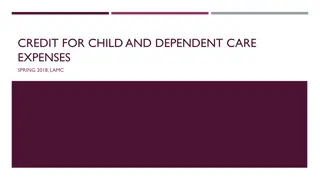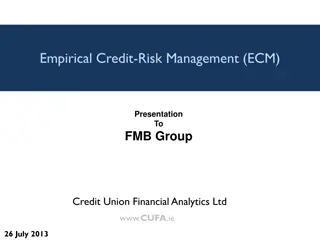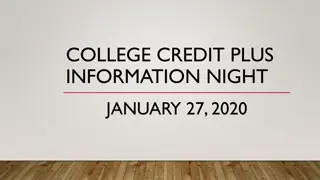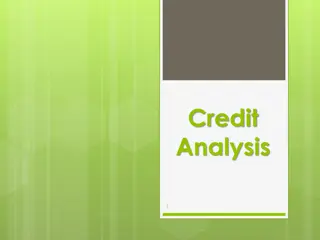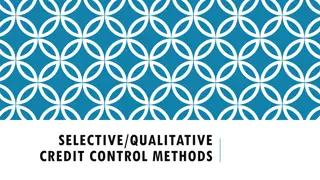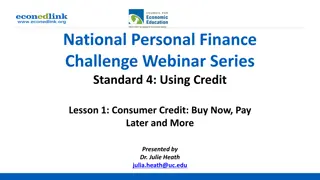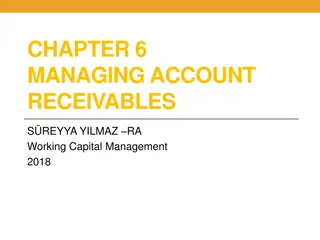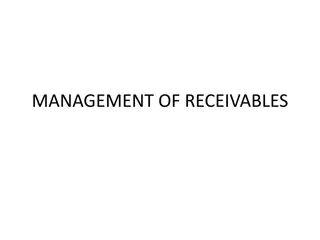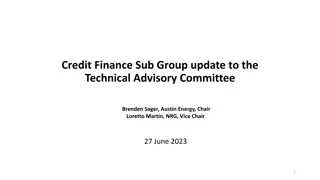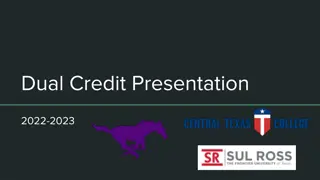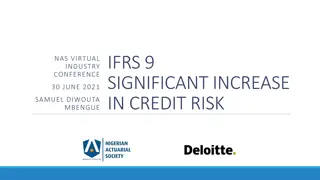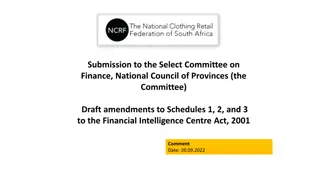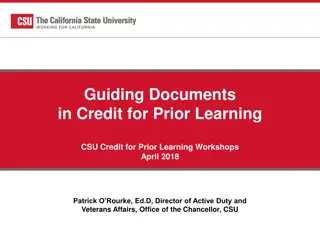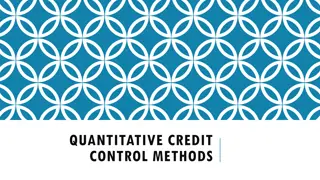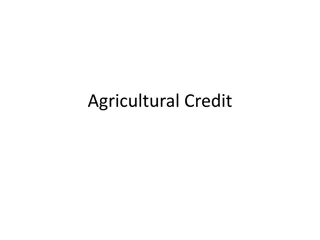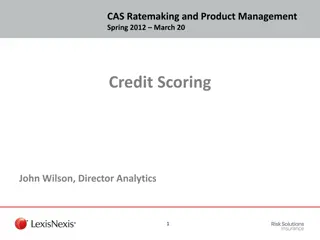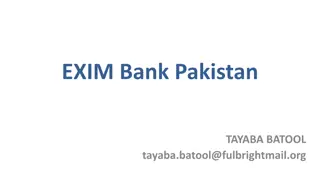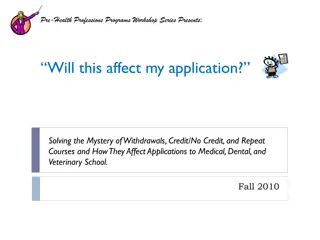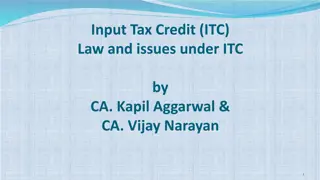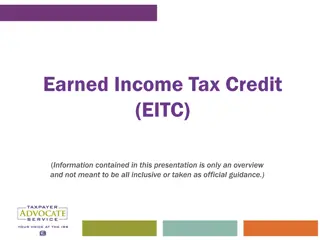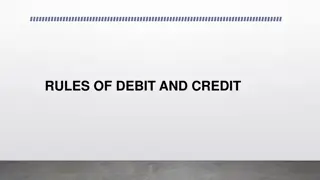Analyzing Business Credit: How to Determine a Good Deal
Understanding how to differentiate a good business deal from a bad one involves assessing factors such as cash flow, collateral, and historical financial data. By conducting a thorough credit analysis and seeking advice from professionals, buyers can mitigate risks associated with loan defaults and ensure the viability of the business they are acquiring.
Download Presentation

Please find below an Image/Link to download the presentation.
The content on the website is provided AS IS for your information and personal use only. It may not be sold, licensed, or shared on other websites without obtaining consent from the author. Download presentation by click this link. If you encounter any issues during the download, it is possible that the publisher has removed the file from their server.
E N D
Presentation Transcript
BUYING AN EXISTING BUSINESS How to Determine a Deal from a Dog
What the Buyer and the Bankers Want: Minimal risk on loan defaults Validated cash flow sufficient to pay debts back Existing businesses use historical data their financial track record The right type and amount of collateral are you buying the Goods and the Bad?
So How Can You Know? Do A Thorough Credit Analysis: A Disciplined Analytical Tool that Helps to distinguish good, bad and gray deals Asks the right questions Provides trend analysis Provides credibility - speaks banker s language Answers 3 of the C s of Business Credit Capacity Cash Flow Collateral YOU SHOULD SEEK EXPERT ADVICE FROM RELIABLE PROFESSIONALS (a CPA or Business Analyst with a forensic financial background)
Credit Analysis Process Obtain Company s AR and AP terms directly from the owners Review three years of historical financial statements to determine if the Company is being operated efficiently Calculate Operating Cycle Verify cash flow is greater than anticipated debt service
Step #1 in the Credit Analysis Process Analyze the Company s Balance Sheet Management of Company s resources Snapshot of what Company owns and owes at one date in time Analyze the Profit and Loss Statement How well the Company buys and sells services or inventory to make a profit
Step #2: Is the Cash Flow Greater Than the Debt Service? Three Demands on Cash Flow Debt Service Permanent Working Capital Capital Expenditures
Cash Flows Existing cash flow pays for debt service Future profits will pay for increases in permanent working capital needs and necessary capital expenditures
Working Capital & Operating Cycles DEFINITION: Cash invested in the operating cycle of the company necessary to make profits Operating cycle is the number of days cash remains invested in inventory that is sold and converts to Accounts Receivable, which get paid back to the company, turning back into cash
Operating Cycle DEFINITION: Number of days Company uses to convert inventory sold back into cash available for use in operations, such as more inventory purchases, debt service, operating expenses Operating Cycle = Days of Inventory + Days of Accts Receivable - Days of Accts Payable - Days of Accrual Sometimes the answer is negative days, particularly for Restaurants
Days in Inventory DEFINITION: Inventory cycle equals the number of days (360 for annual) cash is invested in inventory before being sold and becoming Accounts Receivable. Is the inventory old and still sitting on the shelf, tying up the company s money? Days Inventory = End of year Inventory x 360 days Cost of Goods Sold (COGS)
Days in Accounts Receivable Compare days of Accounts Receivable (A/R) to company s sales terms and industry norms to determine collection efforts. Normal terms net due in 30 days Are the customers late in paying? Is anyone at the company paying attention to who is and who is not paying on time? Days Receivable= End of year A/R x 360 $ Annual Sales
Days in Accounts Payable Compare days outstanding of Account Payable (A/P) to the company s sales terms to its suppliers and industry standards Normal terms net payable in 30 days Are the company late in paying what it owes to suppliers or vendors? Is anyone at the company paying attention to who is and who is not paying on time? Days Payable= End of year A/P x 360 Cost of Goods Sold (COGS)
Days in Accruals Focus on Payroll Accruals, not income or state taxes payable Checking for delinquent payroll taxes Days Accrual= Accruals x 360 COGS
Debt to Equity Ratio Measures financing provided by outside lenders compared to the financing provided by owners and/or investors Debt to Equity=(Total Liabilities- Officer Loans) (Net Worth Intangibles + Officer Loans) Should be less than 1
CASE IN POINT: Magic Fingers, Inc. A Deal or A Dog?? Magic Fingers, Inc. has been very successful in the past by selling custom window treatments Sales strategy: Capture all of the market by beating any advertised price from the Big Box Stores competitors The owners personally own the warehouse and charge rent to the Magic Fingers Company The Magic Fingers Company pays a subsidiary to produce the custom window treatments The owners have invested $400,000 in manufacturing equipment to create treatments in 24 hours by their subsidiary
Lets review Magic Fingers Inc. These statements have been compiled by a CPA . A compilation is ranked as third in reliability of numbers. Highest to lowest reliability starts with an Audit, Review, Compilation, Tax Returns prepared by a professional down to Self-Prepared Tax Returns What is occurring with total liabilities? What is our biggest concern on the Profit and Loss Statement?
Calculate Days Inventory Locate the inventory section on the Balance Sheet, then find the COGS on the Profit & Loss BALANCE SHEET 1993 1994 1995 ASSETS Cash and Marketable Securities Accounts Receivable Inventory 691 829 758 PROFIT & LOSS STATEMENT 1993 1994 1995 Sales COGS 4673 2641 3827 2206 3543 2083 Days Inventory 94 135 131 (Inv/COGS)*360 (Inv/COGS)*360 (Inv/COGS)*360
Calculate the Days Accounts Receivable Look for the Accounts Receivable on the Balance Sheet, then find the Sales account on the Profit & Loss BALANCE SHEET 1993 1994 1995 ASSETS Cash and Marketable Securities Accounts Receivable Inventory 3 4 3 PROFIT & LOSS STATEMENT 1993 1994 1995 Sales 4673 3827 3543 Days Receivable 0.23 0.38 0.30 AR/Sales*360 AR/Sales*360 AR/Sales*360
Calculate the Days Accounts Payable Find the Accounts Payable under the Liabilities section then locate COGS on the Profit & Loss BALANCE SHEET 1993 1994 1995 LIABILITIES & NET WORTH Notes Payable-Bank Notes Payable-Other Accounts Payable 304 377 367 PROFIT & LOSS STATEMENT 1993 1994 1995 Sales COGS 4673 2641 3827 2206 3543 2083 Days Payable 41 62 63 (AP/COGS)*360 (AP/COGS)*360 (AP/COGS)*360
Calculate Days Accrual Find Accruals under Liabilities on the Balance Sheet, then locate the COGS on the Profit & Loss BALANCE SHEET 1993 1994 1995 LIABILITIES & NET WORTH Notes Payable-Bank Accounts Payable Accruals 7 5 4 PROFIT & LOSS STATEMENT 1993 1994 1995 Sales COGS 4673 2641 3827 2206 3543 2083 Days Accrual 1 1 1 (AC/COGS)*360 (AC/COGS)*360 (AC/COGS)*360
Calculate the Operating Cycle Operating Cycle 1993 1994 1995 Days Inventory + Days Receivable + Days Payable - Days Accrual - 94 135 0.38 62 131 0.3 63 0.23 41 1 1 1 Number of Days in Cycle 52 73 68
Calculate the Debt to Equity Ratio BALANCE SHEET 1993 1994 1995 LIABILITIES & NET WORTH Subordinated Officer Debt 162 223 TOTAL LIABILITIES 697 910 928 TOTAL NET WORTH 632 512 414 Debt to Equity Ratio 1.10 1.11 1.11 (Total Liabilities-Officer Loans)/(Net Worth + Officer Debt)
Credit Analysis on Magic Fingers Inc The Quality Indicator Checklist provides some of the questions necessary to determine if Magic Fingers is a deal or a dog. Do you notice any trends? Too many days of inventory vs sales? Why are they riding their suppliers? Are they competitive with the Big Box stores after all? WHAT MATTERS MOST TO THE CUSTOMER? Speed of delivery or cost? Are they using Just-In-Time techniques to control inventory? Do they need better supply chains? What would you recommend the company change or where to rethink strategy? How would you present a loan package to a banker? Remember the banker needs cash flow and collateral
Structuring the Deal Let s review Cash Flow from the Profit and Loss Is there any Cash Flow? What does the negative Gross Profit mean? How could we correct? Which major expense is controllable by the owners?
Collateral Bankers need cash flow and sufficient collateral for any loan What are Magic Fingers assets? What else could the owners offer to the bank as collateral?
Restructuring the Deal OUR STRATEGY: concentrate on quality custom window treatments and turn the price fight back to more quality issues. Offer fast production time at a premium price. Then the gross profit should increase, thus raising the bottom line. What could happen if the price of the products go too high? Requires careful target marketing to smaller commercial /quality-conscious customers If they offer financing, what will happen to the Cash on the Balance Sheet? Offset materials cost with customer down payments in advance on all orders
Packaging the Loan Our strategy: keep at least 14 days of cash on hand Days Cash = Cash / Sales x 360 Obtain a revolving line of credit with an SBA 7A CAP line from the bank/lender to help finance custom jobs. Rent the building or buy it outright? Negotiate rental terms on the building or purchase it outright over 20 years with a SBA 504 mortgage
Moral of the Story SEEK PROFESSIONAL ADVICE. Tap into SBA RESOURCES like the VBOC, SBDC and SCORE for no to low- cost counseling and analysis. Consult with your BAIL Team (Banker, Accountant, Insurance Agent and Lawyer) before signing anything!
Content Credit Johnny Branch, CPA, MBA Certified Business Analyst with the Florida Small Business Development Center, Panama City Dr. Len Eichler, PHD, Certified Business Analyst with the Florida Small Business Development Center, Panama City
